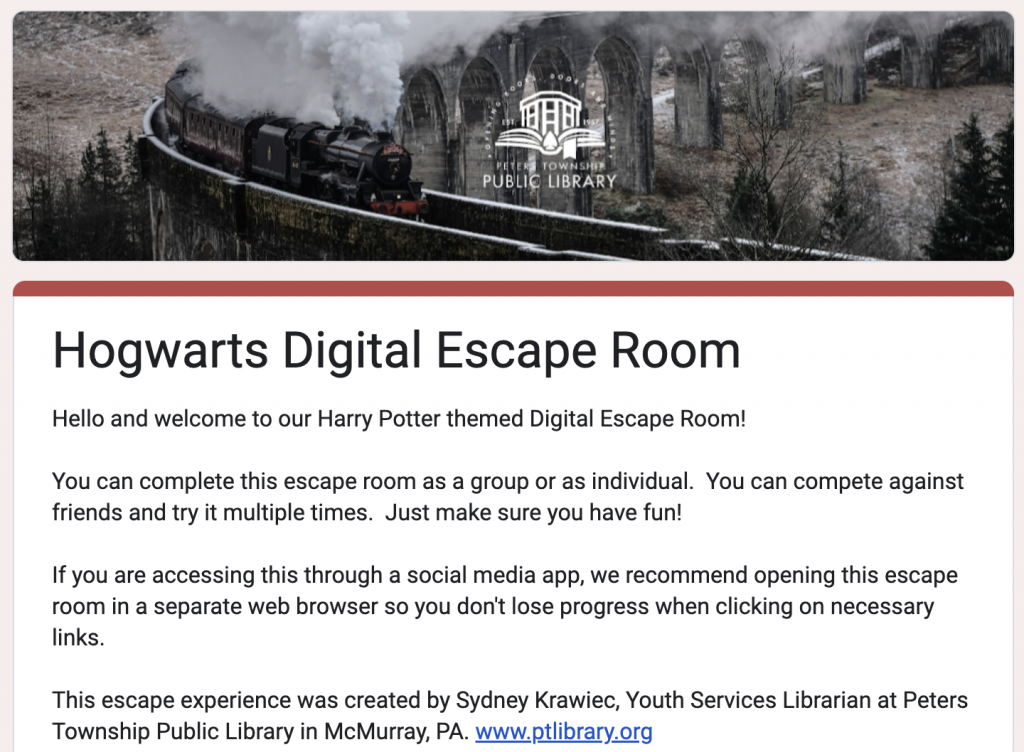Escape rooms: discovering clues, solving puzzles and working as a team
Jamie Heywood

What is the idea?
An escape room is a game where players, working in a team, solve puzzles and complete short tasks. This is typically within a set time limit, with the overall aim to achieve a specific end goal – usually to ‘escape’!
Escape rooms can be set up in a physical environment, with tangible objects, and a focus on exploring the environment and discovering clues. Clues can lead to puzzles; puzzles can lead to answers and answers can lead to further clues. After a series of these have been solved, teams can find a final code or answer, which can be used to complete the escape room (sometimes this is through unlocking a physical door).
The escape room idea is generally believed to be from the video game genre ‘escape the room’, where players find themselves in a locked room and are required to click on their surroundings, explore the environment, and find a way to escape. More advanced virtual escape rooms have since been created, using various programmes and platforms, with the ability to explore an online environment (Nicholson, 2015).
Why this idea?
With well-designed, appropriately challenging escape rooms, players instantly become active participants and develop learning on many levels, working collaboratively towards a shared goal (Veldkamp, Daemen et al., 2020). Desirable skills and qualities such as teamwork, creativity, leadership, communication, decision making, and critical thinking can all be fostered and developed (Fotaris & Mastoras, 2019). Pedagogies such as Inquiry-Based Learning, Scenario-Based Learning, Teams-Based Learning, Games-Based Learning can all be embedded within this methodology to create an engaging, fun, and stimulating activity (Makri et al., 2021). Escape rooms are naturally versatile, with the ability for them to be contextualised to different subject areas and have varied levels of complexity to suit the time required to complete and the level of student. Students can also design their own escape rooms, which can then be completed by other groups afterwards to promote peer to peer learning, creativity, and innovation.
How could others implement this idea?
So how can we create escape rooms? Similarly to curriculum design, the first step should be to establish what the overall intended learning outcome is, which provides a foundation and context to the puzzles and structure (Veldkamp, van de Grint et al., 2020). This may be a certain skill (e.g. communication, teamwork or decision-making) or a certain topic related to the curriculum. A series of puzzles, which link to each other, can then be designed. These can be in categories such as visual (e.g. examining images/surroundings to solve a puzzle), logic (e.g. using reasoning to identify a theme), physical (e.g. undoing a knot or searching an object), auditory (e.g. deciphering a sound), or combination (e.g. a mixture of these grouped together) (60OUT, 2019). Escape rooms can be set up in a physical environment, where clues and puzzles are scattered around the room (see Image 1 as an example). It may help to set up multiple versions of the puzzles, so teams are not reliant on a singular item, and can complete simultaneously. Virtual environments can be set up by creating codes to unlock new content, for example, gaining a password to enter a new tab (e.g. using Microsoft OneNote) (see Image 2 as an example), or a different webpage (e.g. Password Protected Padlets) (Microsoft, 2021; Padlet, 2021). When creating puzzles, it is important that they promote autonomy (teams are self-directed and do not need to rely on support), are achievable (teams should be challenged but able to make progress) and have a focus on collaboration (containing different elements so teams can work together and all members can contribute) (López-Pernas et al., 2019). Small groups of three or four members can be most effective, as decisions can be made quicker, there is a larger feeling of responsibility, and it is easier for teams to bond and synergise. To further develop engagement, collegiality and momentum, puzzles can be scaffolded, with easier ones to begin with before becoming more challenging. By solving puzzles and seeing progress, this creates a sense of achievement and can be a catalyst for added motivation and enjoyment (Prensky, 2001).
When the escape room has been designed, and is ready to be played, it can help to give an opening briefing to clarify the starting point and to set any specific rules. Creating competition by including a reward for the winning team can further gamify the process and provide an added incentive. It is common that teams may become stuck at a particular puzzle and unable to make progress. Due to this, it is worth including the ability to receive a hint, or the answer, after a certain time, to enable the team to continue, as well as tracking the overall progress of each team in order to give support and guidance if required. After a set time, or when a team finishes, reflecting and debriefing on the experience can help align to the outcome, and meaningfully contextualise the learning and skill development that has taken place. If a team has not managed to ‘escape’ within the set time, then collaboratively discussing the solutions of the stages, or puzzles, they did not complete is important as a learning opportunity and to not discourage future escape room usage.
Transferability to different contexts
There has been a range of innovative and inspiring examples of escape rooms used in educational contexts. These have been to teach and develop understanding in key aspects of the student journey such as using the university library (University of Staffordshire, 2022), during the student induction process (Coulson et al., 2020) and digital accessibility (Open University Educational Escape, 2021). They have also been designed to enhance specific areas such as communication (O’Brien, 2021), cyber security (University of Strathclyde, 2022) and breaking down stereotypes (Leeds Trinity University, 2022). These have been mapped to certain themes such as a Zombie Apocalypse (the library has been taken over by zombies! How can you use your library skills to find a solution and save the university?) (Groves, 2019), Harry Potter (a house prefect has locked you in a room and you need to use teamwork to escape – without using magic! See Krawiec (2021) and Image 3) and the authors own design, being an astronaut trapped on their spaceship (which is used to promote educational escape room use!) (Heywood, 2021). By creating a theme or narrative, this helps to foster a fun, playful and immersive experience and strengthens escape rooms being used as a transformative pedagogic approach.
Images



Links to tools and resources
Books:
- Morris, J. (2020). Escape rooms in education: A practical guide. Independently published.
- Nicholson, S., & Cable, L. (2021). Unlocking the potential of puzzle-based learning. Sage.
- Walsh, A. (2017). Making escape rooms for educational purposes: A workbook. Innovative Libraries.
Platforms:
- Microsoft OneNote: https://www.onenote.com/download
- Padlet: https://padlet.com
Web pages:
- Educational escape (Open University): https://edscape.org.uk/
- Escape rooms for learning and teaching (Durham University): https://dcad.webspace.durham.ac.uk/2021/03/19/the-great-escape-escape-rooms-for-learning-and-teaching/
- Escape to the classroom: Challenging learning environments: https://wonkhe.com/blogs/escape-to-the-classroom-challenging-learning-environments/
- OneNote escape rooms: a 10 step guide (University of Derby): https://digitalhandbook.wp.derby.ac.uk/wp-content/uploads/sites/14/2020/06/Escape-Room-Guidance-1.pdf
- What are the 7 types of common escape room puzzles to look for? https://www.60out.com/blog/solve-common-escape-room-puzzles
Videos:
- Gamification in higher education: https://www.youtube.com/watch?v=d8s3kZz1yQ4&ab_channel=TEDxTalks
- OneNote Escape rooms! https://www.youtube.com/watch?v=suKBV82sJOk&ab_channel=MrExham%27sEdTech
References
60OUT. (2019). What are 7 types of common escape room puzzles to look for? https://www.60out.com/blog/solve-common-escape-room-puzzles
Coulson, K., Rice, P., & Bywater, J. (2020). Using escape rooms for student inductions – implications for online delivery. https://pure.northampton.ac.uk/en/activities/using-escape-rooms-for-student-inductions-implications-for-online
Fotaris, P., & Mastoras, T. (2019). Escape rooms for learning: A systematic review. Proceedings of the 13th International Conference on Game Based Learning, ECGBL 2019, Reading, UK. https://doi.org/10.34190/GBL.19.179
Groves, A. (2019). How we used a digital zombie apocalypse to teach students about the library. Digital Technology Group Blog. https://mmitblog.wordpress.com/2019/10/30/teaching-students-about-the-library-with-a-digital-zombie-apocalypse/
Heywood, J. (2021). Virtual Escape Room. https://1drv.ms/u/s!AjIZEFa5iDPUvSvMVM6d2CMM-Qrv
Krawiec, S. (2021). Welcome to the Hogwarts Virtual Escape Room! https://sites.google.com/view/ptpl-virtual-escape-rooms/home
Leeds Trinity University (2022, February 8). Senior lecturer joins forces with international partners to design an escape room game aimed at breaking down stereotypes. News. https://www.leedstrinity.ac.uk/news/archive/2022/senior-lecturer-joins-forces-with-international-partners-to-design-an-escape-room-game-aimed-at-breaking-down-stereotypes.php
López-Pernas, S., Gordillo, A., Barra, E. & Quemada, J. (2019). Examining the use of an educational escape room for teaching programming in a higher education setting. IEEE Access, 7, 31723-31737. https://doi: 10.1109/ACCESS.2019.2902976
Makri, A., Vlachopoulos, D., & Martina, R. (2021). Digital escape rooms as innovative pedagogical tools in education: A systematic literature review. Sustainability, 13(8), 1-29. https://doi.org/10.3390/su13084587
Microsoft. (2021). Introducing OneNote. Retrieved from https://support.microsoft.com/en-us/office/introducing-onenote-38be036d-5b5a-49ad-83be-292fe53ad7b3
Nicholson, S. (2015). Peeking behind the locked door: A survey of escape room facilities. http://scottnicholson.com/pubs/erfacwhite.pdf
O’Brien, R. (2021, March 19). The great escape – Escape rooms for learning and teaching. https://dcad.webspace.durham.ac.uk/2021/03/19/the-great-escape-escape-rooms-for-learning-and-teaching/
Open University Educational Escape. (2021). Educational escape. https://edscape.org.uk/
Padlet. (2021). Padlet about. Who we are, our policies, and links to useful information about Padlet. https://padlet.com/about
Prensky, M. (2001). Digital Game-Based Learning. McGraw-Hill.
University of Staffordshire. (2022). Get back to studying with academic skills. https://libguides.staffs.ac.uk/get-back-to-study/escape-room
University of Strathclyde. (2022). Cyber escape rooms. https://www.strath.ac.uk/is/cybersecurity/cyberescaperooms/
Veldkamp, A., Daemen, J., Teekens, S., Koelewijn, S., Knippels, M & van Joolingen, W. (2020). Escape boxes: Bringing escape room experience into the classroom. British Journal of Educational Technology, 51(4), 1220-1239. https://doi.org/10.1111/bjet.12935
Veldkamp, A,. van de Grint, L., Kinppels, M., & van Joolingen, W. (2020). Escape education: A systematic review on escape rooms in education. Educational Research Review, 31. https://doi.org/10.1016/j.edurev.2020.100364
Image Attributions
Escape Rooms photo by Zachary Keimig on Unsplash
Figure 1. Escape room in action by Bearfotos on Shutterstock.
Figure 2. Example online escape room screenshot by Jamie Heywood is used under CC-BY 4.0 licence
Figure 3. Screenshot of Hogwarts Digital Escape Room by Sydney Krawiec is used with her permission. The train photo at top of page is by K B on Unsplash.


